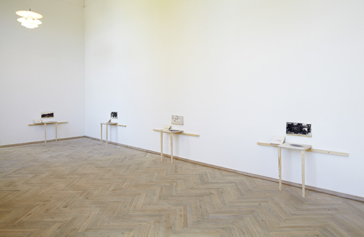
Born in 1974 in Kano (NG). Lives and works in Anvers (BE)

2010
Installation. 6 wooden structures, 18 photographs printed on slabs of Galala Limestone, white pebbles.
Dimensions variables
Year of Purchase: 2013
Otobong Nkanga was born in Kano, Nigeria. She lives and works in Antwerp, Belgium. She studied art at the Obafemi Awolowo University in Ile-Ifé, Nigeria, and then at the École Supérieure des Beaux-Arts in Paris.
Otobong Nkanga is a performer and a visual artist, working in drawing, sculpture, and installation as well as in photography and video. Her practice revolves around the question of landscape and architecture, raw materials and the sites of their provenance, in a quest to find human traces that may attest to specific lifestyles and to environmental, political, and economic issues. The materials utilized, the power of their physical presence, their arrangement, the way the body, prolonged in a line drawn on paper may add to fluidity and meaning, are themes exploited in the work of Otobong Nkanga in an effort make us feel. Our relationship to our body, the engagement of our five senses when we come in contact with her oeuvre, are of primordial importance in her work (for example, the sense of smell in Anamnesis, 2015). This sensory engagement is supposed to provoke our own faculty of memory, memory that is less coordinated or conditioned by reason than memory that we are most likely using on daily basis; it is a powerful, instinctive, and emotive faculty.
The Taste of Stone, 2010, is an in situ work created on the occasion of the artist’s solo exhibition, Make Yourself At Home at Kunsthal Charlottenburg in Copenhagen. The installation offered a twofold experience: in the first room, one could see various rocks, images (of human bodies, different landscapes, and maps), as well as texts printed on white limestone slates placed on top of wooden tablets. The room contained six tablets corresponding to six visual narratives, which told fragments of stories: stories of borders, of rejection and fear, of protection and destruction. Memory. This first space was an introduction and an invitation for the audience to engage our entire bodies in the experience of the encounter with “rock” as material: how it is used, what it feels like to the touch. The work also solicited storytelling, since how else could we connect the different elements we were presented with? In the second room, the audience encountered black gravel and imposing rocks of various dimensions, placed in a sculpted topographic landscape composed of an aggregate of natural iron oxide (magnetite). Epiphytes (plants that don’t need soil to survive) were placed on top of the rocks. Taste of a Stone was a veritable experience of space by way of materiality. Walking on gravel produced a specific sound, and it was possible to feel the texture and the rigidity of the stones by sitting on the ground. Otobong Nkanga wanted to create a landscape dedicated to contemplation and meditation in order to invite us to get a “taste” of stone by accessing different senses. The senses of sight, touch, and hearing are stimulated so that the audience may access different emotions, memories, and moods. As the artist put it, “I read most works through an emotional space. Looking, hearing or tasting something in your mouth and feeling the sweetness or the bitterness, or the shift of sweetness into bitterness, this is quite a crucial part of our everyday life. Aside from the cerebral side, art should touch the soul, engage our emotions and our senses.”1
Eva Barois de Caevel
1 Louisa Elderton, “Interview with Otobong Nkanga,” October 2014, thewhitereview.org.